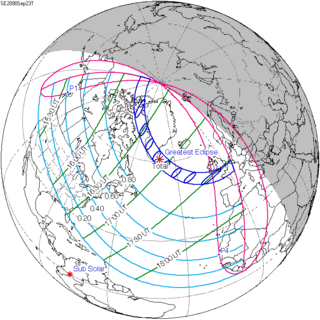| Solar eclipse of September 23, 2090 | |
|---|---|
| Type of eclipse | |
| Nature | Total |
| Gamma | 0.9157 |
| Magnitude | 1.0562 |
| Maximum eclipse | |
| Duration | 216 s (3 min 36 s) |
| Coordinates | 60°42′N 40°30′W / 60.7°N 40.5°W |
| Max. width of band | 463 km (288 mi) |
| Times (UTC) | |
| Greatest eclipse | 16:56:36 |
| References | |
| Saros | 155 (10 of 71) |
| Catalog # (SE5000) | 9711 |
A total solar eclipse will occur at the Moon's ascending node of orbit on Saturday, September 23, 2090,[1] with a magnitude of 1.0562. A solar eclipse occurs when the Moon passes between Earth and the Sun, thereby totally or partly obscuring the image of the Sun for a viewer on Earth. A total solar eclipse occurs when the Moon's apparent diameter is larger than the Sun's, blocking all direct sunlight, turning day into darkness. Totality occurs in a narrow path across Earth's surface, with the partial solar eclipse visible over a surrounding region thousands of kilometres wide. Occurring about 4 hours after perigee (on September 23, 2090, at 12:40 UTC), the Moon's apparent diameter will be larger.[2]
The path of totality will be visible from parts of northern Canada, Greenland, southern Ireland, the southern United Kingdom, France, and Belgium. A partial solar eclipse will also be visible for parts of North America, Western Europe, and West Africa.
This solar eclipse will be the first total solar eclipse visible from Great Britain since August 11, 1999, and the first visible from Ireland since May 22, 1724. The totality will be visible in southern Greenland, Valentia, West Cork, Poole, Newquay, Plymouth, Southampton, Isle of Wight, northern France (including Paris and Rennes) and south Belgium and a partially eclipsed sun will be visible in Birmingham, London, Exeter, Cardiff, Belfast, Dublin, Weston Super Mare, Bristol and Oxford.
- ^ "September 23, 2090 Total Solar Eclipse". timeanddate. Retrieved 24 August 2024.
- ^ "Moon Distances for London, United Kingdom, England". timeanddate. Retrieved 24 August 2024.
